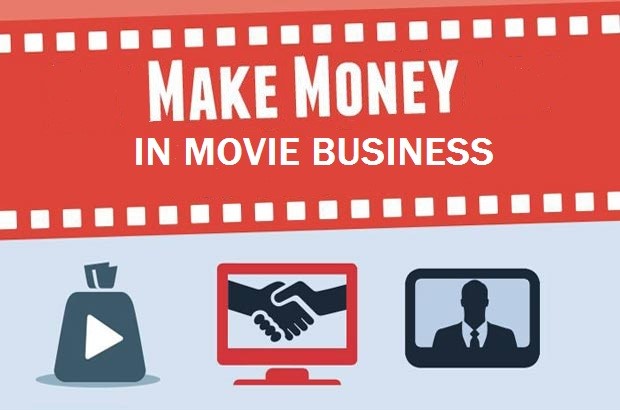Movies making, Going to the movies has always been one of society’s most pleasurable pastimes. Over the past few years, though, enormous changes have occurred in the moviemaking business: escalating production and marketing costs, the significant impact of increased piracy, the uncertainty in film financing, the proliferation of digital technology, and the increase in available entertainment options for consumers. These and other factors have implications for the motion picture business, the types of movies it will produce, and how and where people will view them.
From a distance, the movie business might look pretty glamorous. While there’s a lot of money to be made in the film industry, the economics of making movies are far from simple. At this point, stop and reflect on the reasons you want to make movies on a more serious level. Is it to make money, to influence people, Or to look cool? It really doesn’t matter which reason you choose, and I believe you should choose one. Why not step back and formalize your efforts with the hope of monetizing your work?
In this article, we’ll discuss how the industry operates, the challenges it faces, and what goes into making a movie.
THE INDUSTRY IN PERSPECTIVE
Globally, more than 3,000 feature films reached movie theaters in 2006, bringing in $23.8 billion in box-office revenues. And total global annual revenues across all distribution channels such as video and DVD, cable, television, and mobile sources were forecasted to be $450 billion by the end of 2007, according to the Motion Picture Association of America (MPAA). The largest distributors of feature films in 2006 were India with 800, the U.S. with 599, and China with 255.
Let’s now look at the organization of the U.S. motion picture business. Six major studios make up the motion picture industry’s core: 20th Century Fox, Walt Disney Pictures, Warner Brothers Pictures, Paramount Pictures, Columbia Pictures, and Universal Pictures. The MPAA represents these studios internationally and plays several roles: It advocates for the U.S. film industry, protects producers from copyright theft, and fights piracy. In 2006, the MPAA studios released 203 films (34%), and other independent distributors released 396 (66%).
Even though major studios have made their name in Hollywood, large, vertically integrated conglomerates own them today. These conglomerates also incorporate several other entertainment and media forms, such as radio stations, cable, and network television stations, newspapers, magazines, theme parks, and book publishing (see Table 1). For example, News Corporation owns 20th Century Fox, Fox Broadcasting Company, Direct TV, National Geographic, and The Sunday Times (U.K.). In contrast, Disney owns Walt Disney Pictures, ESPN, ABC, Buena Vista Home Entertainment, and Disneyland. Vertical integration of this magnitude creates enormous barriers to entry for any entity trying to get into the business, in part because they have to gain access to the major distribution channels.
Each major studio has subsidiary studios that produce medium- and small-budget films (see Table 1). Since Paramount purchased DreamWorks and Disney bought Pixar, there are only a few truly independent studios. The most notable independent film company, Lions gate Entertainment, produces critically acclaimed films such as Monster’s Ball and Crash. But even with the existence of these subsidiaries and a few independent film companies, critics have raised concerns that, because distribution is in the hands of a few large companies, the general public has the opportunity to see only a limited number and kinds of films. While this debate goes beyond our article’s scope, there’s concern that independent filmmakers need more opportunities to showcase their work to the general public. For example, film festivals offer such opportunities. There are tens of thousands of films submitted to 3,000 film festivals, but less than one-half of 1% ever makes it part of the 3,000 total feature films.
10 Things you can Learn from Bill Gates and add to Your Business
THINGS YOU NEED TO DO TO START YOUR MOVIE MAKING BUSINESS
-
Create a legal entity for starting your film company
However modest the budget, making one movie usually implies you need to set up a legal entity.
You are going to be running a business no different from other businesses. There isn’t a special legal structure for a film company, is my point. There are several different legal structures you can pick and choose from. Best get some legal advice and also consult with an accountant so you can maximize tax advantages.
Strategies For Rapid Revenue Recovery Post Corvid-19 Economy
In the UK, it’s blindingly simple to set up a company.
- Choose a name: do a quick Google and IMDB search to make sure no one else has already grabbed it. If they have, you need to change it.
- Register and form the company. It’s so easy to do now.
- Get registered for local taxes.
- Get a bank account.
- Get a website – making sure you have the URL of your name
- Register your social media profiles: Twitter, Facebook, Instagram, Pinterest. Make sure these profiles are available in your company’s name too. Start getting followers and likes.
-
Create a business plan for your film
Nothing guarantees success more than a good, solid business plan. Decide what it is you wanted to do and how you are going to do it. Line up a team. Make a budget and schedule. Get an idea of who will fund it and how the money is going to return to investors.
-
Raise some movie money for starting your own film company
Armed with your business plan, hit the campaign trail to get the money to make your dream come true.
There are several different ways to raise money depending on your business plan.
- Take your business plan to one of the big production companies or even a studio.
- Apply for government funding like the UK’s BFI.
- Partner with a producer in another country to bring local public funds to the table (co-production).
- Get money from a brand (product placement).
- Find an angel investor.
- Launch a crowdfunding campaign.
-
Get a filmmaking team.
Any production company of note has 4 key personnel. When you are starting your own film company, you are in the start-up phase. You will deliver many if not all of these key roles yourself. As you grow and develop, and as your social media profiles kick into gear, you will start getting swamped with work, and you will need help.
- Head of development
– to find and assess scripts. - Head of the production
– to make sure the films are created on time and budget. - Head of the post-production
- Head of film sales and distribution
– an increasingly key role. This person will supervise crowd-funding and self-distribution in addition to the traditional sales routes.
-
Film distribution
Embarking on a filmmaking career without a clear distribution strategy is a terribly bad decision. Digital technology advances have democratized the filmmaking process – anyone with very few bucks can make a movie. This has flooded the market with inferior products meaning traditional distribution routes are choked with so-called products driving down prices.
Therein lies the irony: making movies has never been easier and cheaper to make. Distribution has never been more difficult.
PRODUCING A MOVIE
Making a movie follows six phases:
(1) Development
(2) Pre-production
(3) Production
(4) Post-production
(5) Marketing and distribution
(6) Exhibition.
Central to creating any movie is the producer. People often confuse the roles of the producer and another key person—the director. The best way to describe the difference between a producer and a director is that the producer is considered the chief of staff, and the director is the senior line manager. The major creative force behind the project, the director, is the person who actually makes the film, and top directors can earn from $3 million to $10 million per film. The producer, however, has ultimate control of the film and shepherds it from idea inception through distribution. Producers of major films often garner seven-figure salaries plus potential bonuses and participation in the net profit. (The term net profit is one of the most controversial financial constructs in the entertainment industry because the calculation of net profits isn’t straightforward. For instance, the revenues included in gross receipts and costs deducted as expenses are subject to protracted negotiations among the parties involved.) There are many producers, such as executive producers, producers, co-producers, and associate producers. Still, we’ll use the term “producer” to denote the key person responsible for the film. Who can actually call themselves a producer is a point of contention in the movie business.
Development
In the development phase, the producer acquires the intellectual property. A producer may purchase the rights to make a movie based on a novel, short story, play, or video game or as a sequel or remake of a film. Purchasing story rights can be very expensive. For instance, the cost of the story rights for M. Night Shyamalan’s Unbreakable was reputed to be $5 million. The producer also hires a screenwriter, who must transform the basic story idea into a usable script. A major screenwriter in Hollywood can earn up to $1 million to write the first several drafts. The producer often must obtain the initial financing, which is easier if he/she hires a well-regarded screenwriter and some key members of the cast, the director, and the crew.
This sequence of events is by no means linear. For instance, a producer may already be tied to a major studio or may operate independently. Because of a track record, being tied to a studio makes it more likely to find properties. An independent producer will have to put together a package with the script, some cast members and then pitch it to a studio. With the major elements in place, studio decision-makers then must determine whether the movie will be successful.
A popular method in Hollywood uses the comparable approach where major parties to the film go through brainstorming sessions to identify a movie or movie that most closely resembles the project under consideration. Decision-makers match characteristics of the proposed film with comparable films based on the movie’s budget, theme, genre, actors, and director, among other factors. Scenario analysis of potential box-office revenue uses profitability data from large databases.
The comparable approach combines rigorous analysis with gut feelings to determine whether the movie should move forward. Once executives are satisfied with the predicted profitability and secure financing, the studio head green-lights the movie. Major studio movies have become extremely expensive to produce.
Since the budgets of most major movies are extremely high, reducing risk is of paramount importance. Moreover, predicting which movies will be successful is very difficult. Consider Napoleon Dynamite from Fox Searchlight and Stealth from Columbia Pictures. Purchased from the Sundance Film Festival, Napoleon Dynamite cost $400,000 to produce and used a largely unknown cast, but the worldwide box office was $46 million, a return of 5,600%.
Pre-production
In pre-production, the producer will hire the director, cinematographer, unit production manager, production designer, and principal cast. The producer also will scout locations and approve the final shooting script, production schedule, and budget. A producer and casting agent’s critical job is to hire the right talent to work at the right price. A key element that sets the motion picture industry apart from others is that the people who produce, direct, and star in movies have recognizable names and faces on which they trade. This contrasts sharply with the airline industry, in which skilled individuals go about their work every day. Still, each is essentially unknown (except perhaps the CEO) outside of their immediate customers.
A-list talent in Hollywood can make up to $20 million per film, although studios are attempting to reduce these up-front payments instead of a larger percentage of net profits. A small army of technical people, such as set designers, camera operators, lighting specialists, transportation personnel, etc., work on the motion picture. The highest-paid member of the crew is the director of photography. When negotiating the contracts to hire talent for the film, the producer and casting agents also need to consider conditions established by different unions.
The term “union” in the creative industries describes labor organizations that represent technical personnel. The term “guild” describes labor organizations representing creative people, such as actors, producers, and directors. The budget for a film is split into above-the-line and below-the-line segments. Above-the-line costs include everyone who can share profits, including the producer, director, and actors. The below-the-line part of the budget consists of technical people such as the crew, materials, locations, etc.
Actors are also represented by business managers, agents, publicists, and attorneys (some agents and business managers are attorneys) to help them manage their careers. These intermediaries’ existence provides a layer of complexity in the creative industries that don’t exist in most other industries. The main job of intermediaries is to find jobs that suit their clients.
Production
Producers also are responsible for preparing production budgets, and the director implements the actual production (shooting) and post-production budgets. A film’s negative cost—the cost of manufacturing the master print—has several components. These costs include any up-front payments to the talent, such as actors and actresses and other employees; costs of sets; and other costs incurred during the production process. If it’s a studio film, then the studio also charges a fee for using its facilities and interest on the negative cost and overhead. During production, the producer will hire a line producer to monitor the film’s physical aspects and oversee the principal shoot. The line producer also helps monitor the budget closely to make sure there aren’t any budget overruns. Physical production can involve many elements, and specific requests often must be negotiated carefully. For instance, to make the film The Italian Job in 2003, Paramount closed two blocks of Hollywood Boulevard for more than a week at the cost of several hundred thousand dollars. Of course, cost disasters can occur.
Post-production
In post-production, the producer will work with postproduction personnel, including the editor, composer, and visual-effects staff. He/she consults with all creative and financial personnel on the answer print or edited master. He/she works with the financial and distribution entities concerning the motion picture’s marketing and distribution plans in domestic and foreign markets. Major companies such as Industrial Light & Magic can employ hundreds of people if the computer-generated imagery is extensive. Post-production work on Hulk, for instance, is estimated to have cost $10 million. Another high cost for a film is original music— whether it’s original compositions or existing pieces. Major composers can garner seven-figure salaries for an original score.
Table 2 provides a comprehensive example of each high cost for a major motion picture, using Spiderman 2 as an example. One of the most expensive movies of all time, Spiderman 2 in 2004 cost a staggering $200 million to produce, but it also grossed $784 million worldwide over its theatrical run. One of the biggest challenges facing the major motion picture studios is the pressure to outdo them, especially when it comes to sequels. Every sequel in the major Hollywood franchises has cost a lot more money to produce than the previous film in the series.
The Bottom Line
As the saying goes, nobody knows anything in Hollywood. The film industry is in flux, and ticket sales alone don’t drive revenue. There’s merchandising, streaming video, and a plethora of other distribution channels that can you as a filmmaker, producers, and studios turn a profit. So who knows, the little indie that you invest in could be the next “Little Miss Sunshine” Or not. In Hollywood, there are no guarantees.




